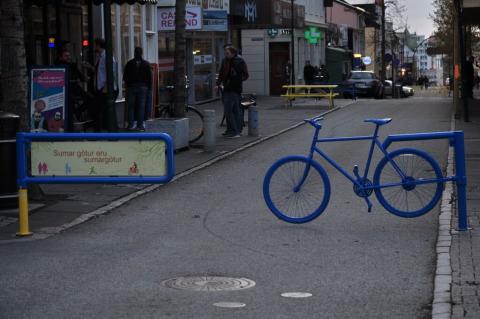After speaking to a couple of locals, taking a look at the local menus, and talking with our fellow travelers, we would like to briefly summarize our observations and conclusions about environmental sustainability in Reykjavik:
Food Security
Iceland as a nation is certainly not deemed food secure. While they do raise a lot of their own meat (such as lamb and horse), as well as fish off of their coasts (including shark, cod, and char), they import a great deal from other countries. Our tour guide Arnie informed us that prior to the 19th century, Iceland did heavily rely on farming to sustain their economy. However, after an abundant of foreign fishing vessels took up permanent residence along Iceland's coasts, the government began building new harbor facilities, and hence fishing became the primary industry.
We can certainly verify that Icelandic seafood is unique and delicious delicacy, which we highly recommend if you ever find yourself in Iceland! We even tried their famed fermented shark, which while wasn't gross, definitely was not yummy-"interesting" is really the best and only word to describe this intriguing dish!
Returning to food security, in addition to fishing, Iceland also produces some of their own meat (mainly lamb), and grows only a small amount of vegetables, including cucumbers, carrots, and potatoes. They heavily rely on food imports, as from their perspective it is cheaper and more convenient.
Transit Systems
Iceland definitely has work to do in order to improve it's transportation system and transit networks. While the transit in Reykjavik is average (consisting of only buses), transit between cities and across Iceland is extremely inconvenient, inefficient, and costly. One local noted it typically costs her the same amount to fly from Reykjavik to Sweden or Reykjavik to elsewhere in Iceland, with flying being the only option. Many Icelanders have expressed interest in adding some sort of rail system to better connect cities throughout the country, however, it does not seem as though a project such as this is on the horizons just yet
Cycling
Cycling does seem to be quite popular and encouraged throughout Reykjavik, which we were all very impressed with. One of the main streets running through to the city centre consists of a separated bike lane on each side of the road, as shown in the below image.

This is an excellent way to ensure a street is considered "complete", and that cyclists feel safe while riding. Consequently, we also noticed several Icelanders cycling to and from work, thus indicating it is a common practice to do so.
Walkability
Lastly, we also paid heed to the high degree of walkable streets in Reykjavik. The second main street (without the bike lane) is only one way for the first half; closer to the city centre and harbor areas, it is then closed off to all vehicles, using these "gates" shown in the below photo.

This is an excellent example of urban planning and design, as it encourages residents and tourists to walk around in the city's hub in a safe environment. Even the section which allows cars is terrific, as the street was clearly designed for pedestrians with motorists as secondary users; therefore, the driving road is narrow with low speed limits while the sidewalks are wider than average with many crosswalks along the way.
Summary and Comparison to Victoria
There are many additional practices and initiatives which Reykjavik has undertaken to be more environmentally sustainable, and likely, there are elements of their urban design and planning which we could also be more critical of. In fact, there are many similarities between the cities of Reykjavik and Victoria, and ways in which the two cities could easily relate with and learn from each other. Food security is an issue in both cities, and while Victoria's transit system may be marginally better than Reykjavik's, Victoria should also be looking to increase connectivity between the inner municipalities (ie. Saanich, Oak Bay, Victoria) and the outer municipalities and further upisland (ie. Sidney, Langford, Duncan, Shawnigan Lake, etc.). Relative to within BC and even throughout Canada, Victoria may be seen as leaders in cycling infrastructure and transit, however, there are still very few, if any separated bike lanes throughout Victoria-Victoria could definitely learn from Reykjavik in this regards. Finally, while Victoria is making progress to becoming more "walkable," there is certainly much room for improvement, primarily with designating more streets as pedestrian only zones.

